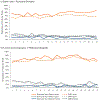Evaluation of Emergency Department-Based Surveillance Systems at 2 Healthcare Facilities After Hurricane Maria: Puerto Rico, 2017-2018
- PMID: 31475668
- PMCID: PMC7050426
- DOI: 10.1017/dmp.2019.79
Evaluation of Emergency Department-Based Surveillance Systems at 2 Healthcare Facilities After Hurricane Maria: Puerto Rico, 2017-2018
Abstract
Objectives: Hurricane Maria caused catastrophic damage in Puerto Rico, increasing the risk for morbidity and mortality in the post-impact period. We aimed to establish a syndromic surveillance system to describe the number and type of visits at 2 emergency health-care settings in the same hospital system in Ponce, Puerto Rico.
Methods: We implemented a hurricane surveillance system by interviewing patients with a short questionnaire about the reason for visit at a hospital emergency department and associated urgent care clinic in the 6 mo after Hurricane Maria. We then evaluated the system by comparing findings with data from the electronic medical record (EMR) system for the same time period.
Results: The hurricane surveillance system captured information from 5116 participants across the 2 sites, representing 17% of all visits captured in the EMR for the same period. Most visits were associated with acute illness/symptoms (79%), followed by injury (11%). The hurricane surveillance and EMR data were similar, proportionally, by sex, age, and visit category.
Conclusions: The hurricane surveillance system provided timely and representative data about the number and type of visits at 2 sites. This system, or an adapted version using available electronic data, should be considered in future disaster settings.
Keywords: disaster; hurricane; syndromic surveillance.
Figures




References
-
- Ardalan A, Schnelle DD. Introduction to Natural Disasters. In: Cittonte GR, ed. Disaster Medicine. Philadelphia: Elsevier; 2016. : 566–568.
-
- Pasch RJ, Penny AB, Berg R. National Hurricane Center website. National Hurricane Center Tropical Cyclone Report Hurricane Maria. https://www.nhc.noaa.gov/data/tcr/AL152017_Maria.pdf. Published April 5, 2018. Accessed August 31, 2018.
-
- Benfield A Analytics: Impact Forecasting. Hurricane Maria Event Recap Report: http://thoughtleadership.aonbenfield.com/Documents/20180328-ab-if-hurric.... Published March 2018. Accessed September 19, 2018.
-
- Santos-Burgoa C, Sandberg J, Suárez E, et al. Differential and persistent risk of excess mortality from Hurricane Maria in Puerto Rico: a time-series analysis. The Lancet Planetary Health. 2018. Oct 12. - PubMed
Grants and funding
LinkOut - more resources
Full Text Sources

